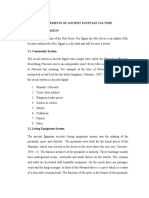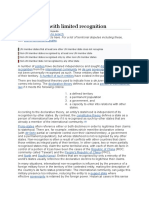0 ratings0% found this document useful (0 votes)
63 viewsCradle of Civilization
Cradle of Civilization
Uploaded by
PunitThe document discusses different perspectives on cradles of civilization. It describes how scholars no longer believe there was a single cradle, as independent civilizations emerged in places like Mesopotamia, Ancient Egypt, Ancient India, and Ancient China. It also notes that the Olmec civilization in Mesoamerica and the Norte Chico civilization in Peru developed independently of the Old World. The document provides context around the concept of cradles of civilization and some of the earliest locations where civilizations are believed to have emerged.
Copyright:
© All Rights Reserved
Available Formats
Download as DOCX, PDF, TXT or read online from Scribd
Cradle of Civilization
Cradle of Civilization
Uploaded by
Punit0 ratings0% found this document useful (0 votes)
63 views2 pagesThe document discusses different perspectives on cradles of civilization. It describes how scholars no longer believe there was a single cradle, as independent civilizations emerged in places like Mesopotamia, Ancient Egypt, Ancient India, and Ancient China. It also notes that the Olmec civilization in Mesoamerica and the Norte Chico civilization in Peru developed independently of the Old World. The document provides context around the concept of cradles of civilization and some of the earliest locations where civilizations are believed to have emerged.
Original Description:
Cradle of civilization
Original Title
Cradle of civilization
Copyright
© © All Rights Reserved
Available Formats
DOCX, PDF, TXT or read online from Scribd
Share this document
Did you find this document useful?
Is this content inappropriate?
The document discusses different perspectives on cradles of civilization. It describes how scholars no longer believe there was a single cradle, as independent civilizations emerged in places like Mesopotamia, Ancient Egypt, Ancient India, and Ancient China. It also notes that the Olmec civilization in Mesoamerica and the Norte Chico civilization in Peru developed independently of the Old World. The document provides context around the concept of cradles of civilization and some of the earliest locations where civilizations are believed to have emerged.
Copyright:
© All Rights Reserved
Available Formats
Download as DOCX, PDF, TXT or read online from Scribd
Download as docx, pdf, or txt
0 ratings0% found this document useful (0 votes)
63 views2 pagesCradle of Civilization
Cradle of Civilization
Uploaded by
PunitThe document discusses different perspectives on cradles of civilization. It describes how scholars no longer believe there was a single cradle, as independent civilizations emerged in places like Mesopotamia, Ancient Egypt, Ancient India, and Ancient China. It also notes that the Olmec civilization in Mesoamerica and the Norte Chico civilization in Peru developed independently of the Old World. The document provides context around the concept of cradles of civilization and some of the earliest locations where civilizations are believed to have emerged.
Copyright:
© All Rights Reserved
Available Formats
Download as DOCX, PDF, TXT or read online from Scribd
Download as docx, pdf, or txt
You are on page 1of 2
A
cradle of civilization is any location where civilization is understood to have independently
emerged. According to current thinking, there was no single "cradle" of civilization; instead,
several cradles of civilization developed independently. Mesopotamia, Ancient Egypt, Ancient
India, and Ancient China are believed to be the earliest in the Old World.[1][2][3] The extent to which
there was significant influence between the early civilizations of the Near East and the Indus
Valley with the Chinese civilization of East Asia (Far East) is disputed.
Scholars accept that the Olmec civilization of Mesoamerica, which existed in modern-
day Mexico, and the civilization in Norte Chico, a region in the north-central coastal region
of Peru which rivals in age the civilizations of the Old World, emerged independent of the Old
World and of each other.[4]
Scholars have defined civilization by using various criteria such as the use of writing, cities, a
class-based society, agriculture, animal husbandry, public buildings, metallurgy, and monumental
architecture.[5][6] The term cradle of civilization has frequently been applied to a variety of cultures
and areas, in particular the Ancient Near Eastern Chalcolithic (Ubaid period) and Fertile
Crescent, Ancient India, and Ancient China. It has also been applied to ancient Anatolia,
the Levant and Iranian plateau, and used to refer to culture predecessors—such as Ancient
Greece as the predecessor of Western civilization.[7]
Contents
1History of the idea
2Rise of civilization
3Single or multiple cradles
4Cradles of civilization
o 4.1Fertile Crescent
4.1.1Mesopotamia
4.1.2Ancient Egypt
o 4.2Ancient India
o 4.3Ancient China
o 4.4Ancient Andes
o 4.5Mesoamerica
5Cradle of Western civilization
6Timeline
7See also
8Notes
9References
o 9.1Citations
o 9.2Sources
History of the idea[edit]
The concept "cradle of civilization" is the subject of much debate. The figurative use of cradle to
mean "the place or region in which anything is nurtured or sheltered in its earlier stage" is traced
by the Oxford English Dictionary to Spenser (1590). Charles Rollin's Ancient History (1734) has
"Egypt that served at first as the cradle of the holy nation".
The phrase "cradle of civilization" plays a certain role in national mysticism. It has been used in
Eastern as well as Western cultures, for instance, in Indian nationalism (In Search of the Cradle
of Civilization 1995) and Taiwanese nationalism (Taiwan;— The Cradle of Civilization[8] 2002).
The terms also appear in esoteric pseudohistory, such as the Urantia Book, claiming the title for
"the second Eden", or the pseudoarchaeology related to Megalithic Britain (Civilization
One 2004, Ancient Britain: The Cradle of Civilization 1921).
Rise of civilization[edit]
Further information: Neolithic Revolution, Urban revolution, and Chalcolithic
The earliest signs of a process leading to sedentary culture can be seen in the Levant to as early
as 12,000 BC, when the Natufian culture became sedentary; it evolved into an agricultural
society by 10,000 BC.[9] The importance of water to safeguard an abundant and stable food
supply, due to favourable conditions for hunting, fishing and gathering resources including
cereals, provided an initial wide spectrum economy that triggered the creation of permanent
villages.[10]
The earliest proto-urban settlements with several thousand inhabitants emerged in the Neolithic.
The first cities to house several tens of thousands were Memphis and Uruk, by the 31st
century BC (see Historical urban community sizes).
Historic times are marked apart from prehistoric times when "records of the past begin to be kept
for the benefit of future generations"[11]—in written or oral form. If the rise of civilization is taken to
coincide with the development of writing out of proto-writing, the Near Eastern Chalcolithic, the
transitional period between the Neolithic and the Bronze Age during the 4th millennium BC, and
the development of proto-writing in Harappa in the Indus Valley of South Asia around 3300 BC
are the earliest incidences, followed by Chinese proto-writing evolving into the oracle bone script,
and again by the emergence of Mesoamerican writing systems from about 900 BC.
In the absence of written documents, most aspects of the rise of early civilizations are contained
in archaeological assessments that document the development of formal institutions and the
material culture. A "civilized" way of life is ultimately linked to conditions coming almost
exclusively from intensive agriculture. Gordon Childe defined the development of civilization as
the result of two successive revolutions: the Neolithic Revolution, triggering the development of
settled communities, and the Urban Revolution, which enhanced tendencies towards dense
settlements, specialized occupational groups, social classes, exploitation of surpluses,
monumental public buildings and writing. Few of those conditions, however, are unchallenged by
the records: dense cities were not attested in Egypt's Old Kingdom and cities had a dispersed
population in the Maya area;[12] the Incas lacked writing although they could keep records
with Quipus which might also have had literary uses; and often monumental architecture
preceded any indication of village settlement. For instance, in present-day Louisiana,
researchers have determined that cultures that were primarily nomadic organized over
generations to build earthwork mounds at seasonal settlements as early as 3400 BC. Rather
than a succession of events and preconditions, the rise of civilization could equally be
hypothesized as an accelerated process that started with incipient agriculture and culminated in
the Oriental Bronze Age.[13]
Single or multiple cradles
You might also like
- Understanding History Book 1Document84 pagesUnderstanding History Book 1afshanaminNo ratings yet
- Civilization: Aboguin, Brian E. 201Ed-Bsed Socstud World History 2Document16 pagesCivilization: Aboguin, Brian E. 201Ed-Bsed Socstud World History 2Vinnie GognittiNo ratings yet
- Ancient HistoryDocument38 pagesAncient HistoryRajesh Kumar DasNo ratings yet
- Lower Palaeolithic Cultures Mentors4IASDocument25 pagesLower Palaeolithic Cultures Mentors4IASambitiousboy225No ratings yet
- Study Guide - All Chapters - WITMDocument389 pagesStudy Guide - All Chapters - WITMwalid ben aliNo ratings yet
- Ancient History As A Term Refers To The Aggregate of Past EventsDocument5 pagesAncient History As A Term Refers To The Aggregate of Past EventsRajshekhar BoseNo ratings yet
- Unit 7Document17 pagesUnit 7Jibannesha BegamNo ratings yet
- Prehistory .. Field Report.. Disha (Merged)Document72 pagesPrehistory .. Field Report.. Disha (Merged)sexysushi1318No ratings yet
- Ancient Civilizations of EuropeDocument2 pagesAncient Civilizations of Europecarola3618No ratings yet
- History 7 - WatermarkedDocument58 pagesHistory 7 - WatermarkedSumegha JainNo ratings yet
- Theme 3Document56 pagesTheme 3Sumit SinghNo ratings yet
- History of The WorldDocument18 pagesHistory of The WorldmagnaiubfNo ratings yet
- 01 Anthropological - Lesson 01 - Historical DevelopmentDocument8 pages01 Anthropological - Lesson 01 - Historical DevelopmentRecto UllaniNo ratings yet
- Susana Widyastuti, S.S., M.A., Ph. DDocument22 pagesSusana Widyastuti, S.S., M.A., Ph. Ddesikuning2002No ratings yet
- Ancient Civilizations ReviewDocument7 pagesAncient Civilizations Reviewjuliamilan999dNo ratings yet
- History of The World (By Muqeem)Document151 pagesHistory of The World (By Muqeem)Muhammad AbdulAzizNo ratings yet
- What Were The Major Achievements of The Egyptians? How Did They Influence Later Societies?Document10 pagesWhat Were The Major Achievements of The Egyptians? How Did They Influence Later Societies?Tonnie KiamaNo ratings yet
- History of The WorldDocument27 pagesHistory of The Worldyanachii22No ratings yet
- World HistoryDocument10 pagesWorld HistoryChristian AlfornonNo ratings yet
- Text The Origins of CivilizationDocument4 pagesText The Origins of Civilizationoscarwood8001No ratings yet
- 142.editedDocument10 pages142.editedTonnie KiamaNo ratings yet
- Key Terms 1200Document59 pagesKey Terms 1200James MarshallNo ratings yet
- Lecture Notes - 7 Elements of Ancient Egyptian CultureDocument5 pagesLecture Notes - 7 Elements of Ancient Egyptian CultureAlifa CantikaNo ratings yet
- Axial Age: Eurocentric Views of CivilizationsDocument1 pageAxial Age: Eurocentric Views of CivilizationsMaxwell_RhodeszNo ratings yet
- YANG (2011) Rise and Fall of Cowrie Shells. Asian Story PDFDocument26 pagesYANG (2011) Rise and Fall of Cowrie Shells. Asian Story PDFpax_romana870No ratings yet
- Biblical Archeology Discovery of Important Inscriptions (Philip, Dr. Johnson C. Cherian, Dr. Saneesh) (Z-Library)Document52 pagesBiblical Archeology Discovery of Important Inscriptions (Philip, Dr. Johnson C. Cherian, Dr. Saneesh) (Z-Library)wp.wiseprophetNo ratings yet
- HistoryDocument60 pagesHistoryyamanuel25No ratings yet
- Ancient HistoryDocument76 pagesAncient HistoryManu DalalNo ratings yet
- Group 1 STSDocument148 pagesGroup 1 STSChloe SantosNo ratings yet
- Civilization 2Document16 pagesCivilization 2breakkayden831No ratings yet
- History of Civilization I - 1005Document77 pagesHistory of Civilization I - 1005cansusunterNo ratings yet
- AP World History Key TermsDocument61 pagesAP World History Key TermsDAJman726100% (5)
- Nubia and Ancient EgyptDocument6 pagesNubia and Ancient EgyptDena ThomasNo ratings yet
- Week 1Document44 pagesWeek 1Rafael EnriquezNo ratings yet
- Mesopotamia Thesis StatementDocument6 pagesMesopotamia Thesis StatementAndrew Molina100% (2)
- Contributions of Early River Valley CivilizationDocument4 pagesContributions of Early River Valley Civilizationapi-327713634No ratings yet
- World History I Pacing GuideDocument38 pagesWorld History I Pacing GuideDiana PhamNo ratings yet
- ArchaeologyDocument3 pagesArchaeologyDishu RanaNo ratings yet
- Chapters Two: The Development of Human Culture OutlineDocument101 pagesChapters Two: The Development of Human Culture Outlinewandimu solomonNo ratings yet
- Chapters Two: The Development of Human Culture OutlineDocument132 pagesChapters Two: The Development of Human Culture Outlinewandimu solomonNo ratings yet
- Bard, K.A Toward An Interpretation of The Role of Ideology in The Evolution of Complex Society in Egypt, Journal of Anthropological Archaeology 11Document24 pagesBard, K.A Toward An Interpretation of The Role of Ideology in The Evolution of Complex Society in Egypt, Journal of Anthropological Archaeology 11Ian Charles LepineNo ratings yet
- Seven Amazing Ancient Civilizations: Magnificent Seven Of Civilizations, Treasure Troves Of Human KnowledgeFrom EverandSeven Amazing Ancient Civilizations: Magnificent Seven Of Civilizations, Treasure Troves Of Human KnowledgeNo ratings yet
- Chapter 1 River Valley CivilizationsDocument34 pagesChapter 1 River Valley CivilizationsTerence ScottNo ratings yet
- Free Research Paper On EgyptDocument5 pagesFree Research Paper On Egyptgvzwyd4n100% (1)
- Human HistoryDocument32 pagesHuman Historyvictor manNo ratings yet
- ST HistoryDocument9 pagesST HistoryThe GreatNo ratings yet
- Clash of CivilizationsDocument44 pagesClash of Civilizationsazerty126No ratings yet
- World HistoryDocument43 pagesWorld Historydhiren1529No ratings yet
- African Civilization (Whole Course)Document4 pagesAfrican Civilization (Whole Course)AnzimNo ratings yet
- Week 3 History Lesson NotesDocument42 pagesWeek 3 History Lesson NotesKassa MekonnenNo ratings yet
- Notes Chapter 3 First CivilizationsDocument2 pagesNotes Chapter 3 First CivilizationsAlicia YuNo ratings yet
- Ancient History Ancient Literature: The Age of Antiquity Early in This Time PeriodDocument2 pagesAncient History Ancient Literature: The Age of Antiquity Early in This Time PeriodRoza PuspitaNo ratings yet
- Module Content 6 Art in Early CivilizationDocument6 pagesModule Content 6 Art in Early CivilizationKaren Manlangit MesinaNo ratings yet
- Chinese MythologyDocument11 pagesChinese MythologyMark AgustinNo ratings yet
- Chapter OneDocument25 pagesChapter Onesaidimounakhaoula10No ratings yet
- Ucsp Q3W4. PresentationDocument34 pagesUcsp Q3W4. PresentationVanessa Mae AguilarNo ratings yet
- HistoryDocument4 pagesHistoryaabdulraheem974No ratings yet
- MesoamericaDocument6 pagesMesoamericaPunitNo ratings yet
- Tuscumbia, Alabama: Jump To Navigationjump To SearchDocument4 pagesTuscumbia, Alabama: Jump To Navigationjump To SearchPunitNo ratings yet
- Huntsville, Alabama: Jump To Navigationjump To SearchDocument5 pagesHuntsville, Alabama: Jump To Navigationjump To SearchPunitNo ratings yet
- Union Territory: Jump To Navigation Jump To SearchDocument11 pagesUnion Territory: Jump To Navigation Jump To SearchPunitNo ratings yet
- Smila: Smila, Greece Smila (Macedonia)Document7 pagesSmila: Smila, Greece Smila (Macedonia)PunitNo ratings yet
- Help:IPA/Ukrainian: Jump To Navigation Jump To SearchDocument10 pagesHelp:IPA/Ukrainian: Jump To Navigation Jump To SearchPunitNo ratings yet
- List of States With Limited RecognitionDocument19 pagesList of States With Limited RecognitionPunitNo ratings yet
- List of 11 CuntryDocument43 pagesList of 11 CuntryPunitNo ratings yet
- Modern Standard Arabic: Jump To Navigation Jump To SearchDocument15 pagesModern Standard Arabic: Jump To Navigation Jump To SearchPunitNo ratings yet
- Number of Native SpeakersDocument22 pagesNumber of Native SpeakersPunitNo ratings yet
- Bill (Law) : Jump To Navigation Jump To SearchDocument9 pagesBill (Law) : Jump To Navigation Jump To SearchPunitNo ratings yet
- Jump To Navigation Jump To Search: This Article Is About The U.S. Territory. For The International Organization, SeeDocument28 pagesJump To Navigation Jump To Search: This Article Is About The U.S. Territory. For The International Organization, SeePunitNo ratings yet
- Unincorporated TerritoriesDocument11 pagesUnincorporated TerritoriesPunitNo ratings yet
- Warehouse ProcessDocument4 pagesWarehouse ProcessPunit100% (1)
- United States Cities by PopulationDocument58 pagesUnited States Cities by PopulationPunitNo ratings yet
- MM ScriptDocument2 pagesMM ScriptPunitNo ratings yet
- The Pyramids Marvels of Ancient EngineeringDocument3 pagesThe Pyramids Marvels of Ancient EngineeringLijithNo ratings yet
- Black Well) The Origins of War - Violence in Prehistory - Guilaine & ZammitDocument296 pagesBlack Well) The Origins of War - Violence in Prehistory - Guilaine & Zammitcucutenilit100% (3)
- The Bronze Age CollapseDocument10 pagesThe Bronze Age CollapseStefan MihajlovicNo ratings yet
- Cyprus Copper Itinerary 2015Document26 pagesCyprus Copper Itinerary 2015asdNo ratings yet
- Upsc Mains Questions Anthropology Paper Ii Topicwise PDFDocument32 pagesUpsc Mains Questions Anthropology Paper Ii Topicwise PDFLalith KrishnanNo ratings yet
- The Archaeologist's Field Handbook: The Essential Guide For Beginners and Professionals in AustraliaDocument18 pagesThe Archaeologist's Field Handbook: The Essential Guide For Beginners and Professionals in AustraliaAli ZoughbaNo ratings yet
- Attila'S Europe?: Structural Transformation and Strategies of Success in The European Hun PeriodDocument29 pagesAttila'S Europe?: Structural Transformation and Strategies of Success in The European Hun PeriodKiss AttilaNo ratings yet
- T02 07 Marojevic - GNP2020Document6 pagesT02 07 Marojevic - GNP2020Kenan KajosevicNo ratings yet
- Journal of Archaeological Science: Christina T. Halperin, Ronald L. BishopDocument12 pagesJournal of Archaeological Science: Christina T. Halperin, Ronald L. BishopGabriela Quiran-JuarezNo ratings yet
- The Early Bronze Age in Western AnatoliaDocument8 pagesThe Early Bronze Age in Western AnatoliaJonNo ratings yet
- Bronze Age HomeworkDocument4 pagesBronze Age Homeworkafmtioefb100% (1)
- Untitled PresentationDocument9 pagesUntitled PresentationSAI HARSHANo ratings yet
- 1 TainoDocument4 pages1 TainoO'Neil Christopher JonesNo ratings yet
- What Was The SphinxDocument9 pagesWhat Was The SphinxKhalid Latif KhanNo ratings yet
- (Budaya Memburu Mengumpul Neolitik) Hunter-gatherer-specialization-in-the-late-Neolithic-of-southern-Vietnam-The-case-of-Rach-NuiDocument18 pages(Budaya Memburu Mengumpul Neolitik) Hunter-gatherer-specialization-in-the-late-Neolithic-of-southern-Vietnam-The-case-of-Rach-NuiJULIZA JATANG ANAK RYSSANo ratings yet
- En Ooru ProjectDocument59 pagesEn Ooru Projectadilshanumm101No ratings yet
- HalafDocument2 pagesHalaftaniyaNo ratings yet
- Are You My MotherDocument16 pagesAre You My MotherVivian Mellon SnyderNo ratings yet
- Tell El-Ghaba I: FiguresDocument295 pagesTell El-Ghaba I: FiguresInstituto Multidisciplinario de Historia y Ciencias HumanasNo ratings yet
- The Rock Art of Portugal A Bibliography PDFDocument120 pagesThe Rock Art of Portugal A Bibliography PDFArchaeoAnalytics MeetingNo ratings yet
- Stone-Age CultureDocument4 pagesStone-Age CultureMate DistributionNo ratings yet
- Ancient Egyptian BiographiesDocument9 pagesAncient Egyptian BiographiesObadele KambonNo ratings yet
- ViolenceDocument776 pagesViolenceVietanh Nguyen100% (1)
- Archaic Sanctuary On Aspis Hill at ArgosDocument12 pagesArchaic Sanctuary On Aspis Hill at Argostoza vitaminozaNo ratings yet
- Acta Diurna in Rome (130 BC)Document1 pageActa Diurna in Rome (130 BC)Krisha GatocNo ratings yet
- Vol 2Document464 pagesVol 2Angel Carlos Perez AguayoNo ratings yet
- The Stone Age 2Document2 pagesThe Stone Age 2prosvetiteljNo ratings yet
- Clarksville 931 221 XXXXDocument189 pagesClarksville 931 221 XXXXpriya selvarajNo ratings yet
- Krapf, 2015. A Typology of The LBA To EIA Pottery of SE AlbaniaDocument32 pagesKrapf, 2015. A Typology of The LBA To EIA Pottery of SE Albaniaadromeda2020No ratings yet
- The First Americans - A Story of Wonderful, Uncertain Science - Aeon EssaysDocument21 pagesThe First Americans - A Story of Wonderful, Uncertain Science - Aeon EssaysYashovardhanNo ratings yet









































































































